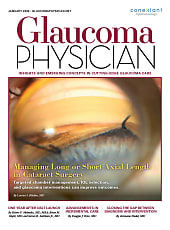With the first quarter of the new year under way comes a flurry of educational conferences, and with them, lots of new technology. One of the most interesting concepts we have been seeing so far is the development of artificial intelligence (AI) software that can assist in surgical planning for cataract surgery. At least 3 major surgical companies, including Alcon (SmartCataract), Bausch + Lomb (Eyetelligence), and Zeiss (Veracity), have developed surgical planning software that allows the surgeon and team to access all of the patients’ data in a single location and utilizes AI to help recommend the best IOL power based on the data.
Gone will be the days of having to manually input data from different devices into an online calculator and having to go back and forth from different output screens or even paper charts. If a practice has multiple measurement devices, let’s say, topographers, all the data from each device can be simultaneously analyzed at one’s fingertips. This will greatly help reduce not only the time it takes to plan a surgery but also reduce transcription errors. With all of the new IOL technology developments, especially in presbyopia correction, accurate and efficient planning is essential.
In addition to using advanced software to plan surgery, we also have the ability now to use technology to help assess patient outcomes. Rayner has developed software (RayPro) to help collect long-term, real-time patient-reported outcomes up to 3 years after surgery using a validated questionnaire to collect insights on spectacle independence, dysphotopsias, and outcome satisfaction. Another software called MDbackline, developed by Dr. John Hovanesian, follows the patient journey and allows more interaction between the patient and the office in terms of helping with better communication, even outside of office visits. It allows for the opportunity to better educate patients on their conditions and treatment options, and it also has the ability to track patient satisfaction.
The landscape of ophthalmology is undergoing a paradigm shift with the emergence of AI. While AI isn’t here to replace surgeons, it holds immense potential to optimize surgical outcomes and enhance patient care.
We had a great conversation with Paul Smith of Orasis Pharmaceuticals, which kicks off the articles in this issue. Following that is a look at using a team approach to ensure patients are being offered the best presbyopia treatment tools and an article that reviews changes in aberrations of the human eye as a function of pupil size and age. We also include a discussion of the use of occupational lenses and a piece on the numbers that make multifocal contact lenses a good opportunity for a practice, as well as tips on keeping patients in soft multifocal contact lenses and pearls about when and how to replace a presbyopia-correcting IOL. Finally, we have some experts’ experience with the PanOptix IOL and the Apthera IOL, before wrapping up with another interesting Clinical Case Corner!
Chief Co-Editors
Jennifer Loh, MD, and Jacob Lang, OD

Dr. Loh is a board-certified ophthalmologist practicing in Miami, FL, with a focus on cataract- refractive surgery and dry eye disease. She is founder and medical director of her practice, Loh Ophthalmology Associates, which she started in 2016. Dr. Loh also spends her time as a clinical and surgical attending physician for the Larkin Hospital Ophthalmology Residency program. She is a graduate of Indiana University School of Medicine, where she completed both medical school and an ophthalmology residency.

Dr. Lang is the lead optometrist at Associated Eye Care in Minnesota and is the director of the practice’s ocular disease residency program. He specializes in cornea and ocular surface diseases, as well as therapeutic contact lenses and surgical comanagement. He is also adjunct clinical faculty at the Illinois College of Optometry, The Ohio State University, and Salus University.








